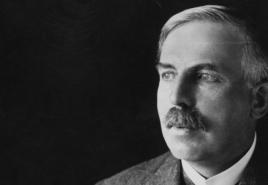Why does the sun shine. Why does the sun shine
The fourth state of matter.
Part six. Why does the sun shine
Why does the sun shine? The same exact answer is known today to this question. The sun shines because in its depths, as a result of a thermonuclear reaction of the transformation of 4 protons (nuclei of hydrogen atoms) into one helium nucleus, free energy remains (because the mass of the helium nucleus is less than the mass of four protons), which is emitted in the form of photons. Photons in the visible range - this is the sunlight that we see.
And now let's reason and imagine the path that scientists have traveled. And at the same time, let's think about what will happen when hydrogen is completely burned out on the Sun? Will it definitely go out? We advise you to read the article to the end - a very interesting assumption is made there.
Let's assume that the Sun burns the most calorific of all types of fuel - the purest carbon, which burns whole, without any ash. Let's do a simple calculation. It is known how much heat this “bonfire” sends to the Earth. The sun is a ball, so it radiates heat evenly in all directions. Knowing the size of the Earth and the Sun, it is easy to calculate that in order to maintain the flow of heat from the Sun, about 12 billion tons of coal must burn in it every second! The figure is huge on the earth's scale, but for the Sun, which is more than three hundred thousand times heavier than the Earth, this amount of coal is small. And yet all that coal in the sun would have to burn out in just six thousand years. But the data of many sciences - geology, biology, etc. - irrefutably testify that the bright Sun has been heating and illuminating our planet for at least several billion years.
The notion that the Sun burns with coal had to be rejected. But perhaps there are chemical reactions in which even more heat is released than when coal is burned? Let's assume they exist. But even these reactions could extend the life of the Sun by a thousand, two thousand years, even twice, but no more.
But if the Sun is not able to provide itself with fuel for any long time, then, perhaps, outer space does this from the outside? It has been suggested that meteorites are continuously falling on the Sun. We have already said that when meteorites approach the Earth, due to braking in the Earth's atmosphere, they often burn out completely, heating the air on their way. Why not assume that there is no atmosphere around the Sun, that the deceleration of meteorites occurs directly in the solar matter, and it heats up to a high temperature?
Let's go back to the calculations. How many meteorites must fall on the Sun to keep it burning for a long time? The calculation gives an absolutely incredible figure: even if the weight of all the meteorites that fell on the Sun is equal to the weight of the Sun itself, it would still shine for only about a million years.
But, perhaps, once such a huge number of meteorites nevertheless fell on the Sun, heated it to a huge temperature, and now the Sun is slowly cooling down? Nothing like this! There is a lot of evidence that the Sun shone and warmed a billion, and a million, and a thousand years ago, as it does today. So, the second assumption also fails.
The amazing constancy of solar activity also buried the third, most tempting assumption about the cause of the "burning" of the Sun. It came down to the following. According to the law of universal gravitation, all bodies approach each other. The Earth is attracted by the Sun and moves around it. The stone is attracted by the Earth and falls on it if it is released from the hands.
Let's imagine that the Sun is a huge vessel with gas. The molecules of this gas, subject to the action of mutual attraction, despite the collisions that throw them away from each other, should gradually attract each other and approach each other. The sun as a whole would then shrink, the pressure of the gas in it would increase, and this would lead to an increase in temperature and the release of heat.
If we consider that in 100 years the diameter of the Sun is reduced by only a few kilometers, then this phenomenon could fully explain the radiation of the Sun. However, such a slow contraction cannot be detected with the help of astronomical instruments.
But there is a “device” that works for a much longer time. This instrument is the Earth itself. During its existence, the Sun would have to shrink tenfold: from sizes many times larger than the length of the entire solar system to modern ones. Such compression would certainly affect the . Nothing like this, however, the history of the Earth knows. She knows major geological catastrophes in which the highest mountains perished, new oceans, entire continents were born, but all this can be fully explained by the activity of the Earth itself, and not the Sun.
So, all three mentioned hypotheses about the causes of the "burning" of the Sun turned out to be untenable. Science, which was able to explain many of the most complex phenomena on Earth, for a very long time lowered its hands before the mystery of the activity of the Sun. Now it has become clear that the solution to this riddle must be sought not in the depths of space, but in the depths of the Sun.
And here the science of the super-large - astronomy - came to the aid of the science of the super-small - the physics of the atomic nucleus.
It's hard to believe, but those stars that shine at night from the sky, and the Sun that illuminates us during the day, are one and the same. Why does the Sun shine during the day and not at night like "normal" stars? Let's dive into the science.
Details about the sun
The sun is the star closest to our planet. The Sun is the center of our planetary system, which got its name from the name of the star - Solar.
The distance from the Earth to the Sun is approximately 150,000,000 kilometers. The mass of a star named the Sun is 330,000 times greater than the mass of our planet. At the same time, the Sun is not a solid body, like the Earth, but is a spherical accumulation of hot gases.
If someone does not believe in the gaseous nature of the Sun, then just imagine: the temperature on its surface is approximately 6000 degrees Celsius. The core (central part) of the Sun is heated to millions of temperatures. No material, alloy or element currently known to science will be able to maintain a solid state at such temperatures.
Why the sun shines: a scientific explanation
It used to be believed that the Sun shines due to the burning of the elements that make up its composition. But according to rough estimates, even rough ones, it cannot “burn out” for billions of years, the Sun should have gone out a long time ago, having lost mass, thereby breaking the gravitational balance in the system of planets and letting them float freely across the expanses of the Galaxy. But this does not happen, the Sun has been shining for billions of years and does not think to dry up. What makes the sun shine?
Scientists have found and proved that the glow of the Sun is the result of the release of colossal amounts of energy obtained as a result of thermonuclear processes occurring in it.
Thermonuclear processes are remarkable in that when matter is consumed, millions of times more energy is released than during combustion. Yes, that's why thermonuclear energy is the future, its minus is the complexity of starting the reaction. To start a thermonuclear reaction requires a huge amount of energy and complex types of consumables, such as synthetic uranium or plutonium.
Why does the sun shine during the day and not at night
Everything is simple here. The very phenomenon of night is the turn of a part of the planet with its "back" to the Sun. And since the planet rotates uniformly around its axis, and the revolution takes about 24 hours, it is easy to calculate the time allotted for the night - 12 hours. So it turns out that half of the Earth is turned towards the Sun for 12 hours and it illuminates it, and in the remaining 12 hours it is on the other side of the globe, not illuminated by the Sun. It turns out that when the Sun shines, we have day, and when the Sun does not illuminate our part of the Earth, we have night. Phenomena such as morning and evening are side effects caused by the ambiguous nature of light and the concomitant effect of diffraction.
So, knowing now why the Sun shines, you should also find out how much he has left to please us. This is about 5 billion years, after losing about a percent of its mass, the Sun will lose stability and go out.
The sun is the source and engine of all life on earth. It gave warmth and light billions of years before the existence of man, and will give it another billion. Where does such power come from? What processes take place on our luminary that allow us to release such a huge amount of energy? How long will our Sun continue to shine? On average, the amount of radiation emanating from each square meter of the solar surface is 62 thousand kilowatts, emitting as much light as 5 million 100-watt electric bulbs could give ... And this for billions of years!The best minds have been wrestling with these questions since the middle of the 19th century, since the laws of conservation of energy were formulated by physicists. The first version was put forward by Robert Mayer, who suggested that the Sun shines due to the constant bombardment of its surface by meteorites. This hypothesis was rejected, since simple calculations show that in order to maintain the luminosity of the Sun at the current level, it is necessary that meteorites with a total weight of 2∙10 15 kg fall on it every second. For a year it will be 6∙10 22 kg, and for the lifetime of the Sun, for 5 billion years - 3∙10 32 kg. The mass of the Sun is M = 2∙10 30 kg, therefore, in five billion years, the substance 150 times more than the mass of the Sun should have fallen on the Sun.
The second hypothesis was due to Helmholtz and Kelvin. They suggested that the Sun radiates by contracting 60–70 meters annually. The reason for the contraction is the mutual attraction of the particles of the Sun, which is why this hypothesis is called contraction. However, if we make a calculation according to this hypothesis, then the age of the Sun is limited to 20 million years, which contradicts modern data obtained from the analysis of the radioactive decay of elements in geological samples of the earth's soil and the Moon's soil.
The third hypothesis about the possible sources of solar energy was put forward by James Jeans at the beginning of the 20th century. He put forward a version that heavy radioactive elements decay in the bowels of the Sun, while energy is emitted. However, calculations show that a star composed entirely of uranium would not release enough energy to provide the observed luminosity of the Sun. But in the Galaxy there are stars, in luminosity many times greater than the luminosity of the Sun.
In 1920, the eminent English astronomer Arthur Eddington (1882-1944) first suggested that thermonuclear fusion could be the source of solar energy. Hans Bethe developed this hypothesis in 1935. He suggested that the source of solar energy could be a thermonuclear reaction of converting hydrogen into helium. For this, by the way, Bethe received the Nobel Prize in 1967.
The chemical composition of the Sun is about the same as that of most other stars. Approximately 75% is hydrogen, 25% is helium, and less than 1% is all other chemical elements (mainly carbon, oxygen, nitrogen, etc.). Immediately after the birth of the Universe, there were no "heavy" elements at all. All of them, i.e. elements heavier than helium, and even many alpha particles, were formed during the "burning" of hydrogen in stars during thermonuclear fusion. The characteristic lifetime of a star like the Sun is ten billion years.
Thermonuclear reactions proceed only at temperatures above 10 million degrees. Such a high temperature can dominate only in the most "central" region of the Sun with a radius equal to about a quarter of the solar one. The energy in this self-controlled thermonuclear reactor is released in the form of hard gamma rays.
The "leakage" of radiation from the center of the Sun to the surface is extremely slow. In this case, in the process of energy transfer from layer to layer, gamma quanta are crushed. First, they turn into X-ray quanta, then into ultraviolet radiation ... It will take about 10 million years until the gamma quanta born in the depths of a star come out of it as photons of visible light. Thus, the light emitted by the Sun today was generated at the end of the Tertiary period, that is, long before the appearance of modern man on Earth.
The main source of energy is the proton-proton cycle - a very slow reaction (characteristic time 7.9∙10 9 years), as it is due to weak interaction. Its essence lies in the fact that from four protons a helium nucleus is obtained. In this case, a pair of positrons and a pair of neutrinos are released, as well as 26.7 MeV of energy. The number of neutrinos emitted by the Sun per second is determined only by the luminosity of the Sun. Since when 26.7 MeV is released, 2 neutrinos are born, the neutrino emission rate is: 1.8∙10 38 neutrinos/s.
A direct test of this theory is the observation of solar neutrinos. High-energy neutrinos (boron) are recorded in chlorine-argon experiments (Davis experiments) and consistently show a lack of neutrinos compared to the theoretical value for the standard solar model. Low-energy neutrinos that arise directly in the pp reaction are recorded in gallium-germanium experiments (GALLEX at Gran Sasso (Italy-Germany) and SAGE at Baksan (Russia-USA)); they are also "missing".
According to some assumptions, if neutrinos have a non-zero rest mass, oscillations (transformations) of various types of neutrinos are possible (the Mikheev - Smirnov - Wolfenstein effect) (there are three types of neutrinos: electron, muon and tauon neutrinos). Because other neutrinos have much smaller interaction cross sections with matter than electrons, the observed deficit can be explained without changing the standard model of the Sun, built on the basis of the entire set of astronomical data.
It is estimated that every second the Sun recycles about 600 million tons of hydrogen. The reserves of hydrogen fuel will last another five billion years, after which it will gradually turn into a white dwarf.
The central parts of the Sun will shrink, heating up, and the heat transferred to the outer shell will lead to its expansion to sizes monstrous compared to modern ones: the Sun will expand so much that it will absorb Mercury, Venus and will spend “fuel” a hundred times faster, than at present. This will increase the size of the Sun; our star will become a red giant, the size of which is comparable to the distance from the Earth to the Sun! Life on Earth by that time must find a new place or form for itself.
Fortunately, this process will occur gradually, and will take about 100-200 million years. When the temperature of the central part of the Sun reaches 100,000,000 K, helium will also begin to burn, turning into heavy elements, and the Sun will enter a stage of complex cycles of contraction and expansion. At the last stage, our star will lose its outer shell, the central core will have an incredibly large density and size, like that of the Earth. A few more billion years will pass, and the Sun will cool down, turning into a white dwarf.
Stars radiate huge amounts of heat and light for many billions of years, which requires a huge amount of fuel consumption. Until the twentieth century, no one could imagine what kind of fuel it was. The biggest problem in physics was the big question - where do stars get their energy from? All we could do was look up into the sky and realize that there was a huge “hole” in our knowledge. To understand the secret of the stars, a new engine of discovery was needed.
Helium was needed to unlock the secret. Albert Einstein's theory proved that stars can get energy from within atoms. The secret of the stars is Einstein's equation, which is the formula E \u003d ms 2. In a sense, the number of atoms that make up our body is concentrated energy, compressed energy, energy compressed into atoms (space dust particles) that make up our universe. Einstein proved that this energy could be released by colliding two atoms. This process is called thermonuclear fusion, it is this force that feeds the stars.
Imagine, but the physical properties of a small, subatomic particle determine the structure of stars. Thanks to Einstein's theory, we have learned how to release this energy inside the atom. Now scientists are trying to simulate the source of stellar energy in order to gain power over the power of fusion in the laboratory.
Inside the walls of the laboratory, near Oxford in England, is the machine that Andrew Kirk and his team are turning into a "star" laboratory. This installation is called Tokamak. It's basically a big magnetic bottle that holds a very hot plasma that can simulate conditions like the inside of a star.
Inside the Tokamak, hydrogen atoms oppose each other. To push the atoms against each other, the tokamak heats them up to 166 million degrees, at this temperature the atoms move so fast that they cannot avoid colliding with each other. Heating is a movement, the movement of heated particles is enough to overcome the repulsive force. Traveling at thousands of kilometers per second, these hydrogen atoms crash into each other and combine to form a new chemical element, helium, and a small amount of pure energy.
Hydrogen weighs a little more than helium, in the process of combustion the mass is lost, the lost mass is converted into energy. A tokamak can support the fusion of a fraction of a second, but in the interior of a star, the fusion of nuclei does not stop for billions of years, the reason is simple - the size of the star.
A star lives by gravity. That's why the stars are big, huge. To compress a star, you need a huge force of attraction in order to release an incredible amount of energy, sufficient for thermonuclear fusion. This is the secret of the stars, this is why they shine.
Synthesis in the core of the sun's star generates every second the power that would be enough for a billion nuclear bombs. A star is a giant hydrogen bomb. Why doesn't it just shatter into pieces then? The fact is that gravity compresses the outer layers of the star. Gravity and synthesis are waging a grand war, the attraction of which wants to crush the star and the energy of fusion, which seeks to blow the star apart from the inside, this conflict and this balance create a star.
This is a struggle for power that continues throughout the life of a star. It is these fights on the stars that create the light and each ray of the stellar journey makes an incredible journey, the light travels 1080 million kilometers per hour. In one second, a beam of light can circle the earth seven times, nothing in the universe moves so fast.
Since most stars are very far away, light travels hundreds, thousands, millions and even billions of years to reach us. When the Hubble orbiting space station peers into the far corners of our universe, it sees light that has traveled for billions of years. The light of the Etequilia star that we see today set off on its journey - 8,000 years ago, the light of Betelgeuse has been on its way since Columbus discovered America - 500 years ago. Even the light of the Sun flies to us for as long as 8 minutes.
When the sun synthesizes helium from hydrogen, a particle of light, a photon, is produced. This beam of light has a long and difficult journey to the surface of the Sun. The whole star prevents it, when a photon arises it crashes into another atom, another proton, another neutron, it doesn't matter, it is absorbed, then it is reflected in a different direction and moving so chaotically inside the Sun it has to break out.
The photon will have to rush wildly, crash into the atoms of the gas billions of times and desperately rush out. It's funny, in order to get out of the core of the Sun, it takes a photon thousands of years and only 8 minutes to fly from the surface of the Sun to the Earth. Photons are sources of heat and light, thanks to which diverse and amazing life is supported on our planet Earth!
Despite the simple wording of the question “Why does the Sun shine?” the answer to it requires some base of physical knowledge and to present it in one sentence is a difficult task. We will try to solve it towards the end of the article, which we will begin with a historical background.
Story
One of the first who tried to approach the explanation of the nature of the Sun from a scientific point of view was the ancient Greek astronomer and mathematician Anaxagoras, according to whom the Sun is a hot metal ball. For this, the philosopher was imprisoned. Before the instrumental study of the Sun began in the 17th century, there was still a lot of speculation about the nature of sunlight, down to the ever-burning forests on the surface.
Since the 17th century, scientists have discovered such a phenomenon as sunspots, it becomes possible to calculate the period of rotation of the Sun. It becomes clear that our star is a kind of physical body with a complex structure. In the 19th century, spectroscopy arose, with the help of which it was possible to decompose the sun's ray into its component colors. Thus, thanks to the absorption lines, Fraunhofer manages to detect a new chemical element that is part of the star - helium.
In the middle of the 19th century, scientists were already trying to describe the glow of the Sun with more complex scientific hypotheses. So Robert Mayer suggested that the star is heated by the bombardment of meteorites. Somewhat later, in 1853, a more plausible idea arose of the so-called "Kelvin-Helmholtz mechanism", according to which the Sun was heated due to gravitational contraction. However, in this case, the age of the luminary would be much less than in reality, which contradicted some geological studies.
Why does the sun shine

The British physicist Ernest Rutherford was the first to come up with the correct answer to this question, who suggested that radioactive decay occurs in the Sun and that it is the source of the star's energy. Later, in 1920, the English astrophysicist Arthur Eddington developed Rutherford's idea, arguing that a thermonuclear fusion reaction can proceed in the core of the Sun under the influence of the internal pressure of the Sun's own mass. After 10 years, the main fusion reactions were calculated, generating the observed amount of energy.
Briefly, the thermonuclear reaction due to which the Sun shines can be described as the fusion of protons (hydrogen nuclei) into a helium-4 nucleus. Since the helium-4 nucleus has a smaller mass than the hydrogen nucleus, the energy difference (free energy) is emitted in the form of photons - particles that are electromagnetic radiation.
thermonuclear reaction
Proton-proton thermonuclear fusion reactions occurring inside stars with a mass of the Sun or less can be divided into three chains: ppI, ppII, ppIII. Of these, ppl accounts for more than 84% of the solar energy. The proton-proton reaction consists of three cycles, where the role of the first is the interaction of two protons (two hydrogen nuclei). With enough energy to overcome the Coulomb barrier, two protons fuse to form a deuteron. Since the deuteron nucleus, consisting of two protons, has less mass than two individual protons, free energy is formed, due to which a positron and an electron neutrino are created, which are emitted from the region where the reaction took place.
Further, due to the interaction of a deuteron and another proton, helium-3 is formed with the release of energy in the form of electromagnetic radiation. The further stages of the reaction can be clearly seen in the diagram below.

Reactions inside the sun
In addition to the proton-proton thermonuclear fusion reaction, a small contribution to the energy released by the Sun is made by a reaction of the proton-electron-proton type 0.23%.
Thus, summarizing the above, the Sun emits electromagnetic waves of various frequencies, including in the visible light region, which are formed by particles born as a result of the released energy during the proton-proton (proton-electron-proton) thermonuclear fusion reaction.







